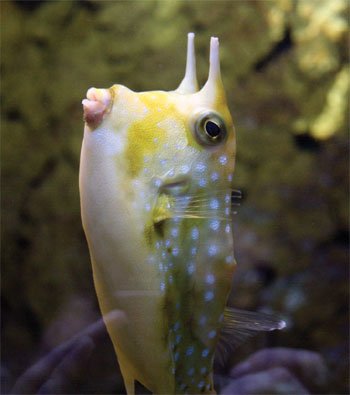Longhorn Cowfish
When foraging, the longhorn cowfish often blows jets of water out of its mouth at the sand surface to uncover buried prey.
Design

When foraging, the longhorn cowfish often blows jets of water out of its mouth at the sand surface to uncover buried prey (this is known as hydraulic jetting). This is an effective method for uncovering hidden prey in sandy lagoon areas that the cowfish frequents.
Features
- This fish is easily recognized by the two long horns that protrude from the front of its head, like those of a cow or bull, and the two spines that project backward at the rear of its body.
- The longhorn cowfish has a yellowish body with white or blue spots. Its horns and tail fin grow very long compared to its body size.
- The cowfish does not have an internal skeleton or scales, but rather a rigid, hard carapace from which the horns, fins, eyes, and lips protrude. This hard, shell-like body acts as protection against predators.
Fun Facts
- This fish is also called the horned boxfish.
- The eyes of the cowfish move independently, so it is able to look in two different directions at the same time.
- The skin of the longhorn cowfish is poisonous, and when threatened it will release a toxin.
CLASS: Actinopterygii (ray-finned fishes)
ORDER: Tetraodontiformes (triggerfishes, pufferfishes, and spikefishes)
FAMILY: Ostraciidae (boxfishes, cowfishes, and trunkfishes)
GENUS/SPECIES: Lactoria cornuta
Size: Up to 20 in (51 cm)
Depth: Up to 165 ft (50 m)
Diet: Algae and crustaceans
Habitat: Sandy lagoons and coral reefs in the tropical waters of the Indo-Pacific region
Aquarium Guide
With fun facts about more than 100 animals, this long-awaited Aquarium Guide includes beautiful pictures and reveals the incredible facts and design features that point to our amazing Creator. This handy size guide is excellent for school field trips and family trips to your favorite aquarium!
Browse Kids Book- © 2025 Answers in Genesis
- Privacy Policy
- Contact
- About

